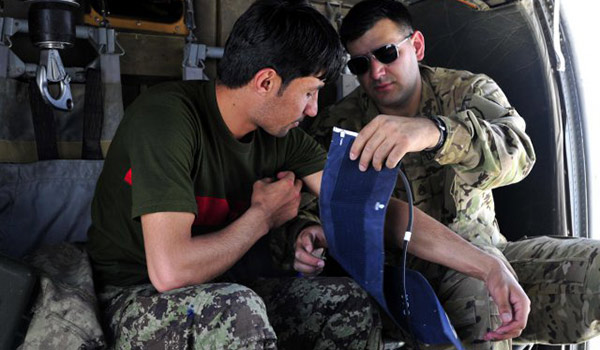
Ask the Flight Surgeon / By Dr. (LTC) Joseph Puskar: Q: I was notified I failed level one cardiac stress testing during my annual flight physical. What do we have to do now?
FS: Cardiovascular disease is the single most common medical cause of loss of flight status in both military and civil aviation. The screening methods available today help identify aviators at higher risk of heart attack and stroke, and possible incapacitation during flight operations, and for whom further testing is indicated. Risk factors that can easily be screened for in the primary care clinic include smoking history, hypertension, diabetes, hyperlipidemia, obesity, family history of premature cardiovascular disease, and increased waist circumference signifying the presence of underlying, bad acting abdominal visceral fat.

Photo: army.mil
For Army aviators, the level one cardiac risk factors considered annually are age, family history, blood pressure, smoking history, serum lipids, blood sugar, and electrocardiographic evidence of ventricular hypertrophy or other heart conduction abnormalities. Using these parameters, a program in the on-line flight physical data entry system, AERO, automatically calculates the Framingham cardiac risk index, and the possible presence of metabolic syndrome. If the latter is suspected, a waist measurement may also be needed to help determine the presence of abdominal visceral fat that has negative metabolic effects contributing to metabolic syndrome and resulting increased risk of future adverse cardiovascular events resulting from an increased inflammatory state from elevated cortisol levels and several other pro-inflammatory mediators. Metabolic syndrome is defined as a waist circumference greater than forty inches in men, high triglyceride levels, low HDL cholesterol, high blood pressure or being treated for it, and high fasting blood glucose.
Level two cardiac testing consists of either an aeromedically exercise-graded exercise tolerance test (AGXT, or stress-treadmill test) or an electron-beam computed tomography (EBCT) to check for calcium in the coronary artery walls (a sign of atherosclerotic plaques), and if either of these is abnormal, to proceed to level three, non-invasive testing of either thallium or sestamibi stress testing, or stress echocardiogram. For practical purposes in recent years the AGXT stress treadmill is usually the test of choice for level two screening.
Despite the availability of all this testing, a recent, somewhat discouraging Air Force study of a large cohort of asymptomatic aviators showed a very low frequency of positive findings for coronary artery disease using screening echocardiography, nuclear stress imaging, and cardiac fluoroscopy. These three non-invasive tests performed in 903 risk stratified, asymptomatic, trained aircrew yielded only a 16%, 21%, and 29% positive predictive value respectively. The annual event rate of death, heart attack, or revascularization procedures was only 0.5% for exercise and nuclear stress testing subjects regardless of the results of the testing, and a 1.1% annual event rate for those with calcified coronary arteries as seen by fluoroscopy. These low rates are likely due to a generally younger and fitter cohort of military aviators that go through a more rigorous selection process especially for high performance aircraft. And even though the positive predictive values of currently available testing and screening for any given individual are necessarily poor due to low statistical, actuarial likelihoods of incidence, values such as the Framingham index are the best we have for population-based risk stratification.
Signs and Symptoms
Luckily, in-flight cardiac events are extremely rare, but as evidenced by a few recent cases in Army aviation, the first signs and symptoms of coronary artery disease are often dramatic, incapacitating, or even fatal. Not insignificantly, two recent sudden cardiac arrest fatalities happened in older contractor aviators who had long-standing, significant cardiac risk factors such as smoking, lack of regular exercise, dyslipidemia, and hypertension. Unfortunately, by the time clinical symptoms such as chest pain or decreased exercise tolerance develop the atherosclerotic plaque progression is usually extensive, not limited to the coronary arteries, and it is much more difficult to treat successfully, and to return the affected individual to flight status. High potency, high dose statin therapy with either Crestor or Lipitor has shown promise over the past several years in reducing atherosclerotic plaque volume and reducing risk of cardiac events.
hese types of medications also significantly increase the risk of developing type 2 diabetes; ask your doctor if they are a reasonable treatment option for your particular lab values and ability to tolerate exercise, modify diet, and so on.
This case should serve as a reminder for us all to maintain the highest possible level of aerobic and overall fitness, avoid smoking, follow a heart-healthy, low inflammatory diet, and keep as close to an ideal body weight as we can. Taking these simple steps will go a long way toward reducing our risk of heart attack and stroke.
Question for the Flight Surgeon?
If you have a question you would like addressed, email it to This email address is being protected from spambots. You need JavaScript enabled to view it..”>This email address is being protected from spambots. You need JavaScript enabled to view it.. See your unit flight surgeon for your personal health issues. The views and opinions offered are those of the author and researchers and should not be construed as an official Department of the Army position unless otherwise stated
Dr. (LTC) Joseph Puskar is a flight surgeon at the U.S. Army Aeromedical Center, Fort Rucker, AL.










